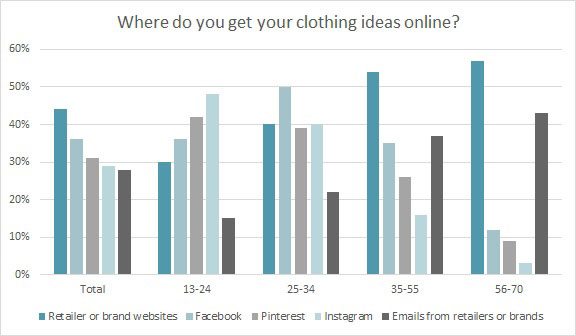You know what people do within minutes of waking up everyday? After sadly reconciling that they can’t just turn over and go back to sleep and then kicking the pets off the bed, they’re checking their smartphones. And that checking just continues all day long, with the perusal of texts, email, and social notifications. Now, smart apparel retailers are taking advantage of that quasi-addiction by targeting social media platforms with fun and easy shopping opportunities.[quote]
Participation and investment in social media for your business has become a necessity, when once it was a luxury.
Rick Wolf
Executive Director, North Market Development Authority
In the Deloitte 2016 Global Mobile Consumer Survey, the firm found that more than 40 percent of consumers check their phones within 5 minutes of waking up. First they check texts and instant messages (35 percent), followed by email (22 percent), and then social networks (12 percent). And the phones get checked 47 times a day.
Now, consider that Statista shows the number of social network users around the world reached 2.34 billion in 2016, and that’s expected to rise to nearly 3 billion by 2020. That adds up to 118 minutes — yup, nearly two full hours — per day simply checking Facebook, Tumblr, Instagram, Twitter, Snapchat, etc.
So it makes sense then that nearly a third of consumers say they get their apparel ideas online from social media platforms, according to the Cotton Incorporated Lifestyle Monitor™ Survey. The top network for this is Facebook (36 percent), followed by Pinterest (31 percent), Instagram (29 percent), Twitter (13 percent), and Tumblr (10 percent).
At the National Retail Federation’s Big Show earlier this month, Rick Wolf, executive director of the Columbus, OH-based North Market Development Authority said retailers are at different levels when it comes to social media participation. Some, he said, are very tech savvy with social media, multiple platforms, and a “tip top” website. A second group may have a website but rarely posts and may have a Facebook page, but doesn’t post to it. And then there’s a third who he says only uses email because he “made it mandatory.”
Wolf says retailers and brands need to understand that social media is not just for nonsense and memes.
“Participation and investment in social media for your business has become a necessity, when once it was a luxury,” he said. “It’s just part of doing business. Many people get discouraged by the abundance of social media platforms and how to use them. Don’t be afraid. Having a social presence is one of the easiest ways to connect with customers, prospects and build brand loyalty and brand awareness.”
With so many platforms and so many ways to connect within each of them — photos, videos, chats, video stories, livestreams — brands and retailers could feel paralyzed by indecision. But industry execs might take inspiration from a number of brands that are trying to do more than just maintain a social media account; they’re trying to truly connect.
The outdoor gear retailer REI decided to use Facebook 360-degree videos (immersive virtual reality pieces) to make the outdoors seem more accessible to multicultural Millennials living in Austin, Chicago and Los Angeles. The retailer created three two-minute videos that feature local artists from the three cities — which also have a strong REI presence — who explain how their art meshes with the outdoors in their respective towns. In the videos, each artist described how being outdoors in their respective cities influenced their creative process.
More than 1 in 5 consumers (22 percent) say social media sites are the first places they go to get clothing ideas, according to Monitor™ data. But the difference between young and older consumers is stark: More than 2 in 5 consumers under the age of 35 (41 percent), significantly more than their older counterparts (11 percent), say social media sites are the first places they go to get clothing ideas.
Perhaps that’s why Bloomingdale’s and adidas turned to Snapchat for recent campaigns to drive consumers in-store. The platform is used by 37 percent of 18-to-24 year olds and 23 percent of 13-to-17 year olds, according to Statista. That compares to just 12 percent of those 35-to-54 and 2 percent of consumers aged 55+.

Bloomingdale’s and adidas both used the interactive components of the Pokémon Go! game. Bloomingdale’s ran a nationwide campaign last fall that used Snapchat geofilters as part of a scavenger hunt sweepstakes. After taking selfies with filters that were hidden in stores, users could direct message the pictures to Bloomingdale’s to win prizes, including gift cards and fall merchandise. The adidas campaign promoted the brand’s NMD line of sneakers. adidas placed street signs around Los Angeles and New York so players could find their adidas Street Team, unlock geofilters and learn about the NMD shoes — and then go to an adidas Originals store to unlock a special filter for a chance to win concert tickets.
Then there was that very humorous 2015 “documentary” for Plas+ique, new high-fashion plastic pants. The doc was ostensibly about this new high-fashion trend, but Fruit’s brightly colored men’s boxer briefs were clearly visible throughout the piece. The campaign was outdoor, digital, and on social media accounts — and eventually spawned a hip-hop song.
Wolf also pointed out that companies really get to build their personality online by using social media.
“Social media with a purpose is essential,” he stated. “The advantages are the ability to get a leg up on competition by connecting with current and prospective customers in an organic way. It gives businesses access to millions of customers and is either free or affordable. There’s no cost outside of your own time. It’s becoming more pay to play, which we all expected. But still, if you want to pay a few bucks these channels offer advanced and affordable advertising platforms that let you target consumers by demographics, keywords and interest based campaigns.”
